Comfrey — How to Use Medicinally as Oil and Salve

by Corinna Wood
Curious about comfrey uses? Although today comfrey is considered controversial, this herb's medicinal usage actually dates back throughout the ages. Many a wise woman knew how to use comfrey, a medicine plant that grew at her doorstep.
I'll share with you my favorite uses for comfrey, and you'll learn how you can bring comfrey into your garden and your life.
First, a quick story.
When I first met comfrey, we were on no uncertain terms: comfrey was not my friend.
It was the dawn of my granola years, in college, and I was determined to have a garden. I biked down to the community garden and found my personal plot. It was buried in a sea of comfrey.
At the time, I didn't know what comfrey was. All I knew was that it wasn't corn, and was not tomatoes. And it was in the way.
But whatever I tried to pull out simply broke off. I finally sat back to wipe the sweat off and looked around. This weed was all over the garden!
 The garden coordinator laughed and said, "Careful where you toss that stuff. You're looking at a new patch of comfrey wherever it hits the ground."
The garden coordinator laughed and said, "Careful where you toss that stuff. You're looking at a new patch of comfrey wherever it hits the ground."
Turns out the reason it spread so far is that a volunteer ran a tiller straight through a nice little comfrey patch. And then tilled on through the rest of the garden.
Like a mythical monster, the smallest bit of comfrey root can sprout a whole new plant. It's the plant that keeps on giving. You can chop comfrey to the ground and it will come back, enough to be harvested three or four times a year.
But excuse me, did I say harvest?
It's true, over the years, she became a beloved herbal ally of mind. Just let me share some of her virtues . . .
Table of contents
- Finding comfrey
- How to use comfrey medicinally
- The comfrey controversy
- Recipe ~ Comfrey salve and oil
Finding comfrey
 First thing first. As with all wild green and growing things it’s essential to be certain who you’re working with.
First thing first. As with all wild green and growing things it’s essential to be certain who you’re working with.
Comfrey, Symphytum officinale, is a cultivated herb. So look for her in garden beds. And when you find a friend with comfrey plants, just break off a tiny section of root to start your own!
Comfrey has large broad leaves deeply textured by veins that grow outward from a central midrib in a pattern resembling alligator’s skin. Her leaves—and stalk—are fuzzy with hairs covering both front and back.
Comfrey blooms in the early summer. The purple bell-like blossoms unfurl in a spiral pattern.
As you know, it's essential to positively identify any plants you're harvesting for food or medicine. First things first: Grab my free guide on 3 Poisonous Plants to Watch Out For (pdf) so you can stay safe on your herbal adventures.
Comfrey — how to use medicinally
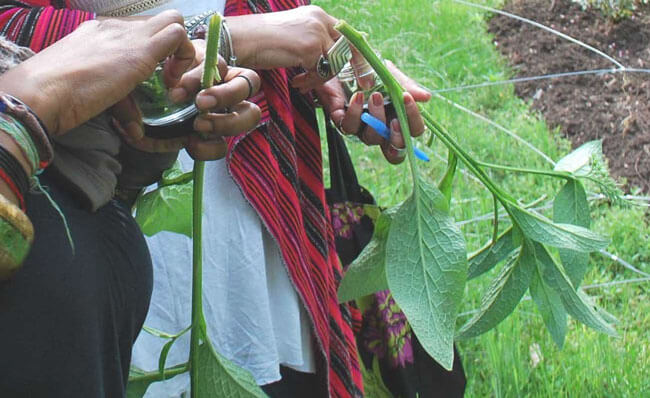 They say if you can't beat 'em, join 'em, and it was in trying to get rid of comfrey that I learned to appreciate her. Comfrey's Latin name is Symphytum officinale, and symphytum actually means to join or unite—in essence, to heal.
They say if you can't beat 'em, join 'em, and it was in trying to get rid of comfrey that I learned to appreciate her. Comfrey's Latin name is Symphytum officinale, and symphytum actually means to join or unite—in essence, to heal.
The same properties that enable comfrey to regrow a whole new plant from a bit of root can also help the body heal injuries of the skin, joints, and muscles.
Internally, comfrey has traditionally also been used to support the connective tissues—as well as respiratory, digestive, and urinary systems. However, due to the controversy surrounding comfrey, I primarily focus on comfrey's external uses (more on the comfrey controversy below).
Comfrey uses and benefits for skin repair and moisturizing
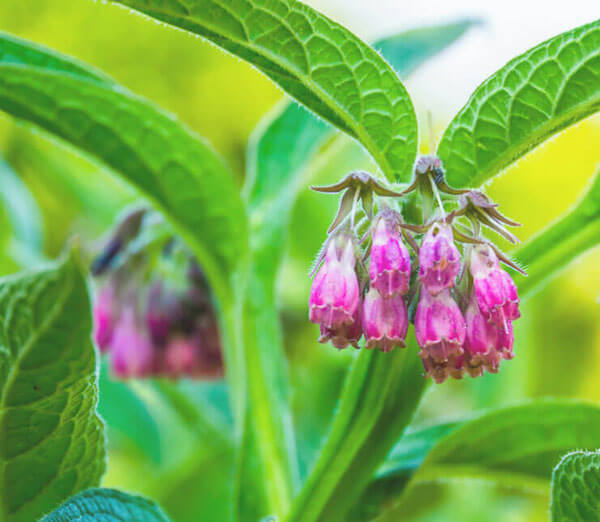 Comfrey is so effective at supporting cell proliferation that one actually has to be careful using it.
Comfrey is so effective at supporting cell proliferation that one actually has to be careful using it.
Comfrey is appropriate for shallow cuts, scrapes and bruises.
For deep wounds, using comfrey on the surface of the wound can actually cause the skin to close over, trapping infection inside.
In that situation, another herb such as plantain (Plantago lanceolata or P. major) or yarrow (Achillea millefolium) would be more appropriate.
Comfrey oil and salve are also used for people with dry skin, chapped lips, eczema, and burns (in the later stages, after the initial hot sensation has subsided).
Comfrey also has specific uses for women, and I know many sisters who swear by it.
Comfrey oil or salve is a powerful ally to address vaginal dryness—especially helpful in breast-feeding, menopausal and post-menopausal years. Comfrey moisturizes and strengthens the vaginal tissues without any added fragrances or preservatives. (Do bear in mind that oil degrades condoms—so with condoms, only water-based lubricants should be used.)
During pregnancy, comfrey oil is a favorite for belly massage, promoting elasticity and preventing stretch marks. I know midwives who rave about how mamas who use comfrey salve on their perineum during pregnancy, tend to have much less tearing during birth.
Many new mothers rely on comfrey salve for diaper rash. The salve even provides quick relief and speedy healing from sore and cracked nipples (apply after breastfeeding, and wipe the area gently before the next feeding).
I got a call a few weeks ago from an elderly woman who was suffering so badly from eczema that the skin on her hands was cracking open. She had used a variety of creams and lotions that doctors had prescribed over the years, all to no avail.
After using comfrey salve for just two days, the pain was gone and the skin had actually closed over her knuckles. Needless to say, she was delighted!
Talia's story of how to use comfrey for broken bones
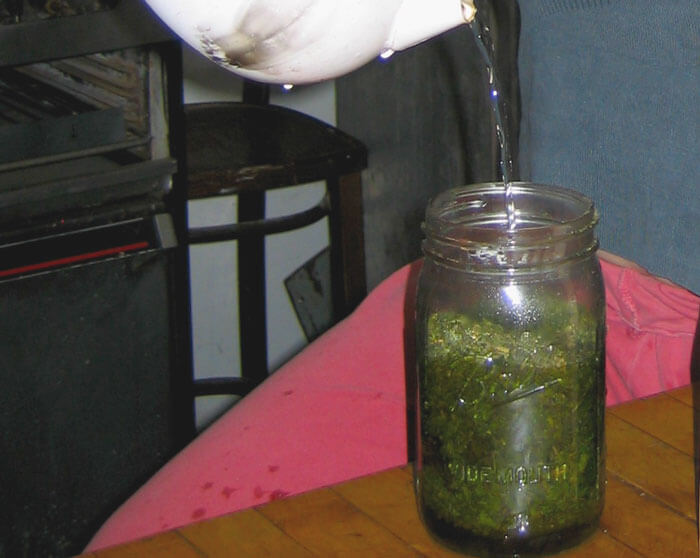 During my college years, a lovely lady living nearby befriended me, and she helped me come to appreciate comfrey.
During my college years, a lovely lady living nearby befriended me, and she helped me come to appreciate comfrey.
I was especially impressed when I witnessed Talia using comfrey to speed up the healing of her broken foot. Comfrey is also known as “knitbone herb” because you can use comfrey to help knit your bones back together!
After breaking her foot, Talia was given a removable cast, with instructions to return to the doctor after 6 weeks to inspect her progress. Having some familiarity with how to use comfrey internally and externally, Talia made an herbal infusion every day for the next two weeks.
She put a cup of dried comfrey leaf in a quart-size canning jar, filled the jar with boiling water, and put a lid on it. After at least 4 hours of steeping, she strained out the plant material and packed it on her foot as a poultice. She drank the liquid over the day, either reheated or at room temperature, sometimes sweetened with honey.
Talia marveled at how quickly the pain and swelling decreased. In fact, she called in to see the doctor a month early.
When the doctor took new x-rays, they were amazed to discover that the bone had nearly fully mended. Her doctor said it was the quickest recovery she'd seen of a break of that kind.
When Talia tried to tell her about comfrey, the doctor pooh-poohed the herb and chalked it up to a miracle! In my book, it's just another story of the magic of herbal medicine the wise woman way.
The comfrey controversy
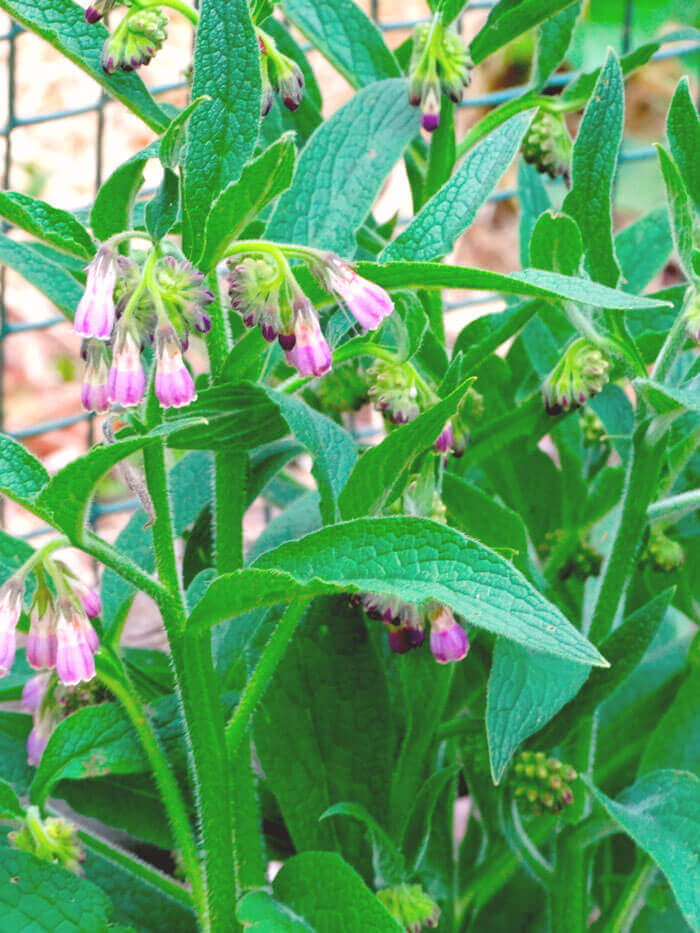 In Europe, for generations, comfrey was one of the plants that almost everyone kept right outside their doorstep, and this revered medicine plant followed us to the new world.
In Europe, for generations, comfrey was one of the plants that almost everyone kept right outside their doorstep, and this revered medicine plant followed us to the new world.
More of a domesticated plant than a weed, comfrey has long been an essential part of the traditional herbal medicine chest to treat a wide array of ailments. That's how it earned the second part of its name, officinale.
Until recently, comfrey was an official medicine, one of a handful of the most respected medicine plants that merited "officinale" in their Latin names. Those fond of manicured lawns might recognize another member of the royal dispensary, dandelion (Taraxicum officinale).
Today, most doctors don't just discount comfrey, they warn against using it. Comfrey has been declared unsafe by the FDA for internal use. If comfrey has been used for centuries, why is it now considered toxic and too dangerous to be used medicinally?
The FDA's declaration was based on a study in which the pyrrolizidine alkaloids were extracted from the roots of comfrey and injected in large doses into rats. Researchers found that this caused pre-cancerous liver changes in the rats, which became translated as "comfrey causes cancer."
Many herbalists have called this study into question. Injecting oneself with a drug made in a lab from comfrey roots is very different than drinking a cup of tea.
As herbalists Mary L. Wulff-Tilford and Gregory L. Tilford state, "In thousands of years of use by millions of people, only two reports of hepatotoxicity (liver cell toxicity) have been documented in humans." And in both these cases, poor nutrition, pre-existing illness, and the use of liver-toxic drugs were contributing factors.
In addition, the leaves, which have much lower concentrations of these alkaloids, can be used instead of the roots.
Nevertheless, this article focuses primarily on using comfrey externally. Of course, the safety issues only apply to taking comfrey internally; for many ailments comfrey can be be of support externally.
Making comfrey salve and oil
Externally, my favorite comfrey use is for moisturizing, healing, and strengthening the skin. And the primo preparation method for this is comfrey salve—or the comfrey oil from which the comfrey salve is made.
Comfrey salve is made by melting beeswax into comfrey oil for a firmer consistency. In general, salves keep longer than oils and are easier (less messy) to keep close at hand in your satchel or backpack.
Wanna know how to make your own comfrey salve? You're in for an herbal adventure...
Recipe ~ Homemade Comfrey Salve
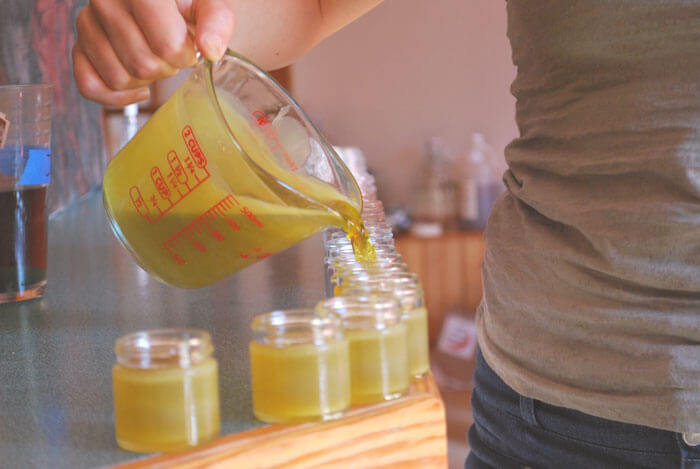
Making comfrey oil
- Harvest the comfrey leaves* in the afternoon, after the sun has dried off the morning dew. Wet plant materials will make moldy oils, so it is best to wait at least 36 hours after the last rain before harvesting.
- Wilt. In a warm, dry, well-ventilated place (such as an attic, an oven with a pilot light, or even your car!), wilt the whole fresh leaves for 12 hours or more, until the edges are crispy.
- Stuff your jar completely full of the whole wilted leaves, leaving a little headroom. Add olive oil until the jar is full to the brim.
- Seal and label. Tightly seal the jar. Label it with the plant name and date harvested. Put it in a dish on the counter (herbal oils always leak).
- Tend it a few times a week by poking the plant material down to release air bubbles and topping it off so the level of the oil is above the level of the leaves.
- Strain. After six weeks, strain out the plant material, and your infused oil is ready to use!
Making comfrey salve
- Grate beeswax. Grate a tablespoon of beeswax for each ounce of infused oil.
- Warm the oil on low heat, add the grated beeswax, and stir until melted.
- Pour the liquid into a jar and allow to cool and solidify. (Note: if consistency is too hard, remelt and add more infused oil, if too soft, remelt and add more wax.)
*You can also use this recipe for making comfrey root oil. Wash and slice the roots to expose them to air so they can wilt in a warm, dry spot. It may take 24-36 hours for the edges to get crispy.
Befriending comfrey salve for your medicine chest
If you're like me—I daresay, a rather wild woman who loves the green and growing things—you'll enjoy exploring how to use comfrey in your medicine chest.
For starters, reach for comfrey the next time you have issues pop up with dry skin, eczema, shallow cuts or abrasions, and burns.
You can even make your own comfrey salve to stash in your first aid kit so it's handy when you need external support with cell repair for strong and supple skin.
In the garden, comfrey is a prolific plant that will grow almost anywhere. She's happiest in rich, moist soil in full sun to partial shade.
As long as the roots are undisturbed, comfrey will stay put (just don't rototill your comfrey patch!).
Today, my initial frustrating encounter with comfrey makes me smile. As I came to appreciate her many virtues, I asked her to be my friend after all.
May you too befriend comfrey for your medicine chest!
Spread the wise woman ways! Link to this article from your website, or share with your friends using this button~
Comments ~ what stands out for you today?








